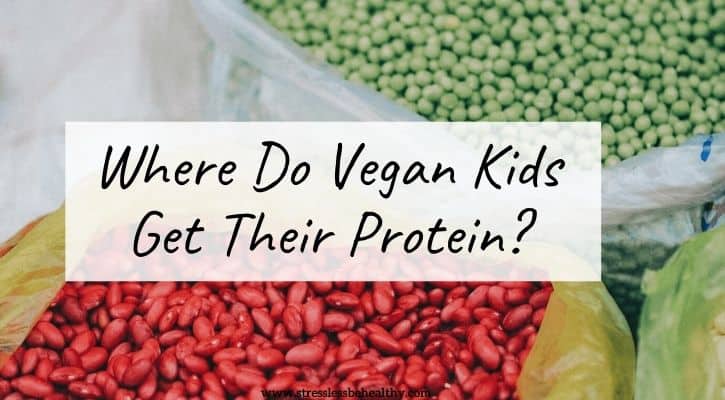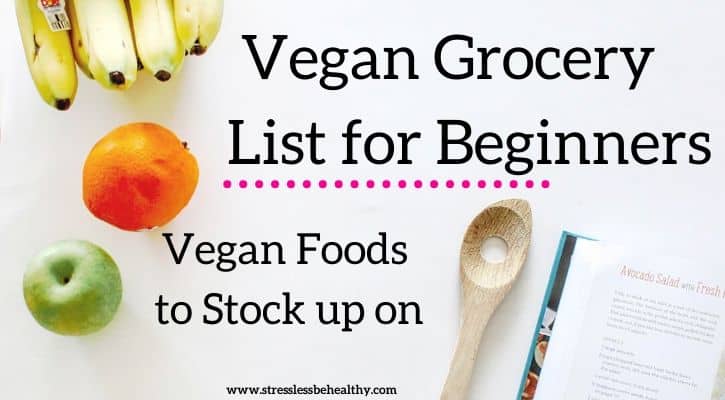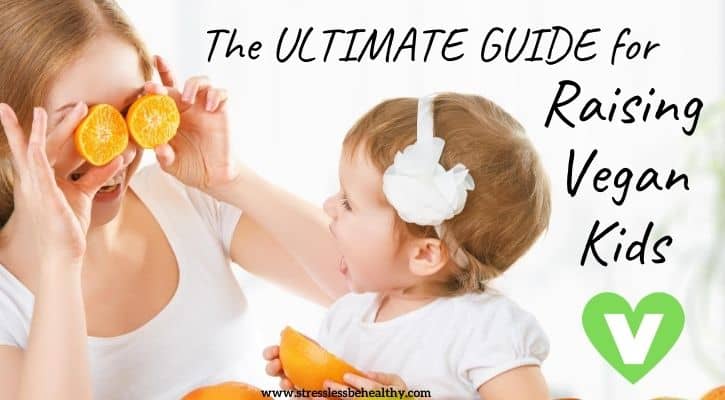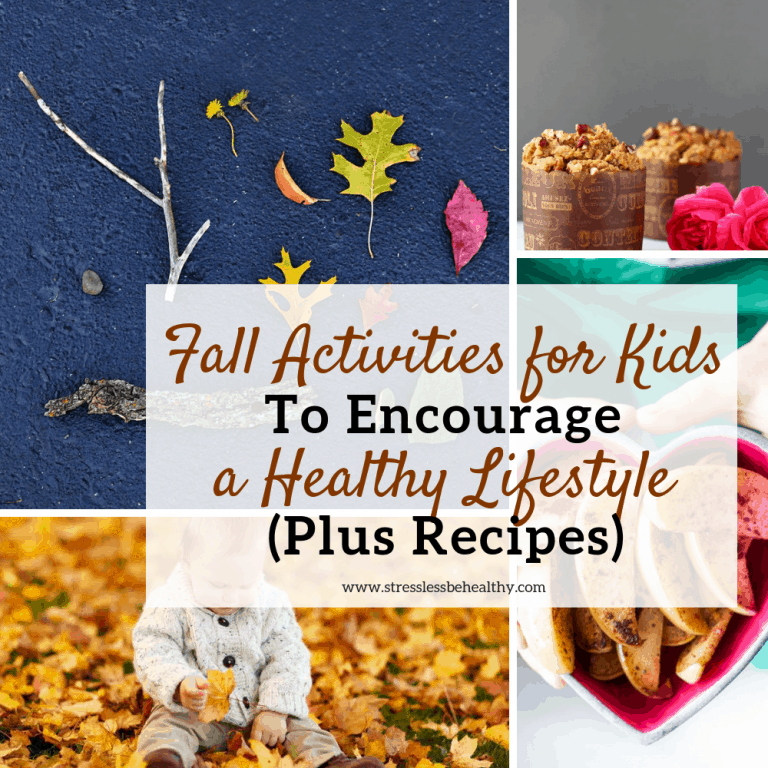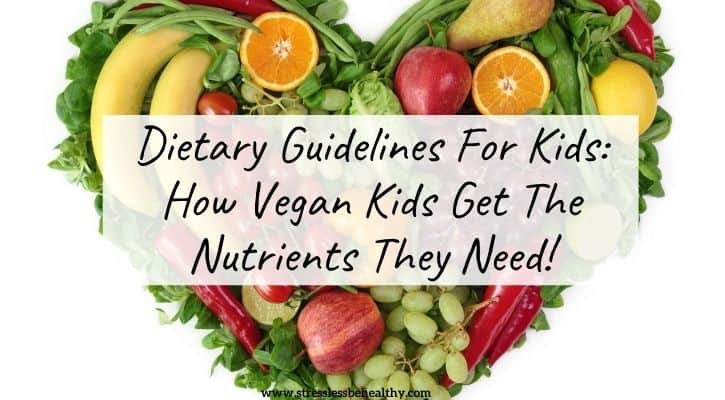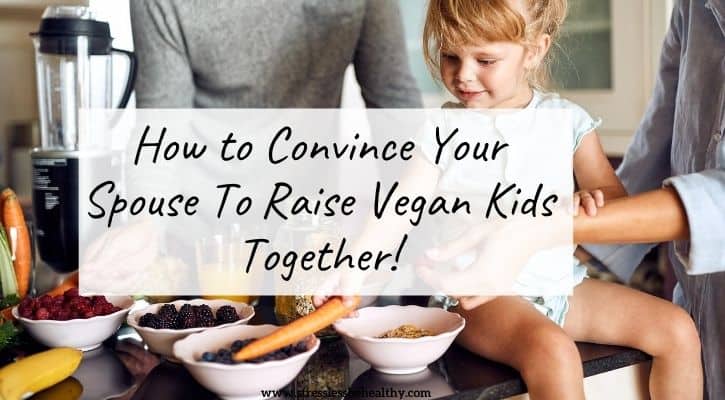How to Teach Children to Build a Healthy Plate
*Disclosure: some links may contain affiliate links. For more information on what this means, visit my disclosure page.
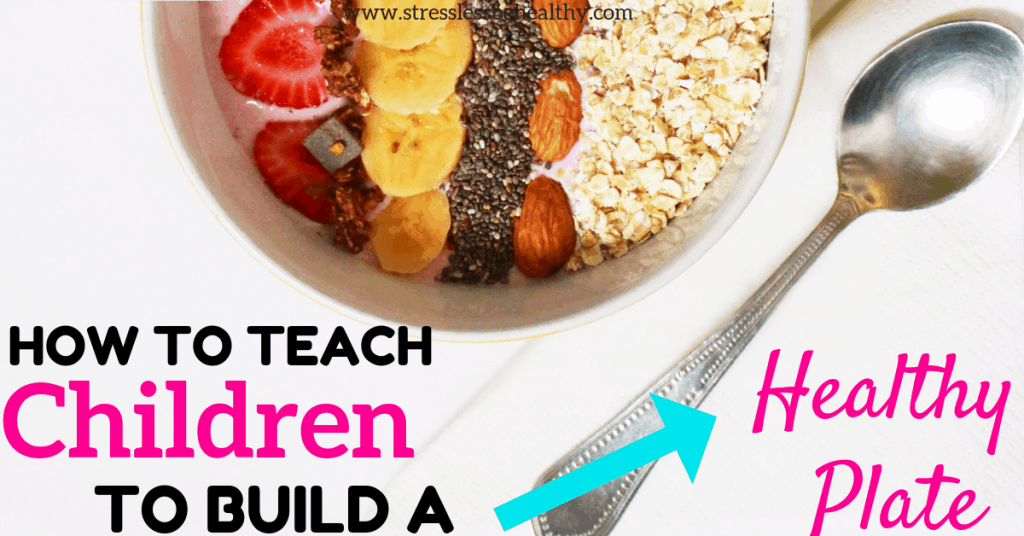
How to Teach Children to Build a Healthy Plate
If you grew up and went to school in the United States, then you probably remember the food pyramid; which has changed through out the years. And, then became myplate; which makes everything a whole lot easier when explaining the concept of healthy eating to kids and helping them make a healthy plate for themselves
However, myplate is slightly skewed and biased; it was created by a government organization, so it kind of had to be!
I would love to get into the socio-economic side of myplate and why it show cases all of the food groups it does, such as dairy. Since dairy is not necessary in the human diet; many people actually can’t even have dairy because they’re allergic to it or have an intolerance to it. (*Hint- it’s just the calcium we need, and can get from many other sources.)
Harvards Nutritional Science department has made their own version of a healthy plate, too. You can see it here, and they did a little better job, as they included water in theirs. Plus, their kids version is kind of adorable. But, it’s still not quite right! (Who do you think funds their studies?)
But, I’m not going to get into that now, as all you want is to know how to teach your child how to make a healthy plate for themselves!
Related Posts:
14 Healthy Habits for Kids That You Can Help Them Develop
Basics of Healthy Eating: Do’s and Don’ts | Healthy Eating Tips
The Easiest Way to Find Out What Food Kids Will Eat!
Want to Remember This? Pin How to Teach Children to Build a Healthy Plate to your favorite Pinterest Board!!
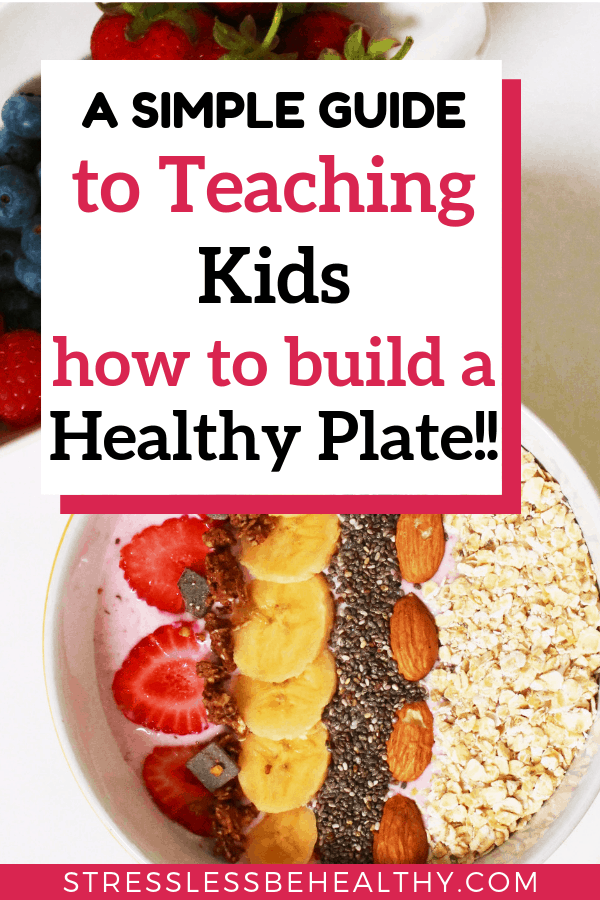
So Then, What is a Healthy Plate of Food?
Starting simply, a healthy plate will contain mostly plant based foods.
If life were perfect, then it would be 100% plant based food. But, we’re not aiming for perfection here; that’s too much pressure, especially on kid.
So, let’s dissect what an actual healthy plate looks like and answer the question: What should a kid eat each day for a balanced diet?
**Disclaimer: I am not a registered dietitian, physician, or a professional nutritionist. I simple believe in eating well for people of all ages, and I believe that a whole foods plant based diet is eating well, whereas processed foods are not. This site and/or any guides I create are not to be used to diagnose, prevent, or treat any health issues. All posts/text on this site/in this guide is for informational purposes only, and I am not liable for how you interpret the information provided.
Let’s Start with the Cup on the Side of a Healthy Plate
For the cup on the side of the plate; myplate chooses to have it contain dairy.
But, as mentioned before, dairy is not necessary in the human diet. The main component in dairy that is suggested we need, is calcium.
Calcium can easily be found in many different vegetables and easily consumed that way.
There is NO need for dairy in the diet.
If you’re thinking, ‘Well, I was always told to drink my milk to avoid osteoporosis when I’m older.’
Take a look at this article (from Harvard): https://www.hsph.harvard.edu/nutritionsource/what-should-you-eat/calcium-and-milk/calcium-full-story/
It not only shows that calcium isn’t the only nutrient in play when it comes to avoiding osteoporosis, but it also discusses how increased intake of dairy can actually lead to certain cancers!
So, instead of having dairy, make water your drink of choice!!
Honestly, it’s quite surprising that myplate doesn’t encourage drinking water. The human body is made up of more than 50% water, therefore we need to stay hydrated; the best way to do that is by drinking water!
So, let’s get our kids started with the good habit of drinking water as young as we can; that way it’s no big deal when they’re older. They’ll know that water is the most important drink for them to have; not milk.
I’d even go as far to recommend everyone in your home having a water bottle, that way they can bring water everywhere they go!
Veggies!!
The next important piece of the puzzle, for a healthy diet and healthy plate, is vegetables.
Now, you may be dreading this and thinking to yourself, ‘Great….my kid won’t eat veggies…’
If this is what’s on your mind, then please do yourself a favor and think hard about what you’re thinking and why.
Do your kids really not like veggies?
Or, are you creating a self-fulfilling prophecy for your kids by saying they won’t eat veggies?
Sometimes, simply saying that your kids won’t eat veggies will make it so they won’t. It enables them to think it’s ok to not eat them, because you said they won’t anyways!
It also enables you to not have to make veggies and try making them in different, or new, ways.
Kids don’t start life hating on veggies! It’s learned.
So, please, do yourself and child a favor, and when teaching them how to make a healthy plate for themselves, make almost half the plate full of veggies!
If half the plate being full of veggies is too overwhelming, start with maybe 30% and work your way up. If that means you have to learn how to cook with more veggies, then so be it!
If your skills in the kitchen aren’t that great, go on youtube and find videos on different ways to cook veggies or incorporate them into meals.
It may feel overwhelming at first, if you’re used to filling your cart with processed food and breeze right through the produce section at the store.
But, you and your child need veggies in your diet, and a lot of them; they are the real super foods and contain so many vital nutrients! (Such as many vitamins, minerals, protein, and carbs!)
Choose from any and all veggies; challenge your child to eat all the colors of the rainbow in veggies each day!
Veggies = ~30-50% of a healthy plate
*Note- this is not an excuse to fill half your plate with fries or white potatoes!
Related Posts:
How to Get Kids to Eat Vegetables: 12 Different Ways!
18 Hidden Vegetable Recipes for Kids
A Stupid-Simple Way to Get Toddlers to Eat Veggies
Fruit!!
If you struggle with veggies, fruits may be a bit easier to fit on your childs healthy plate!
Now, don’t replace veggies with fruit, but fruit should take up about 30%, or more of a healthy plate, as well.
Fruit is natures candy, and also provides many vitamins, minerals, and even carbs!
Fruit is also the best fast food you or your child can have.
Really, how hard is it to give your child a piece of fruit to eat, whether as a side to a meal or as a snack?
You wash it and hand them the fruit, and they eat it. That’s about it!
Depending on the fruit, you may have to skin it or cut it up.
If your child thinks eating a piece of fruit is boring, there are many, many different ways to change fruit and add it into something else for them to enjoy it; such as smoothies, muffins, oatmeal, etc.!
*Note- children do not need juice, and should really only have juice if it’s freshly made or are told to by a doctor (such as if your child is sick and having a hard time getting any fluids what-so-ever).
Choose from any and all fruits, nothing is off the table. Challenge your child to eat all the of colors of the rainbow each day in fruit!
Fruit = ~30% (or in it’s own bowl!)
Whole Grains
Notice how I said whole grains and not just grains?
Myplate recommends to have at least half your grains in the day be whole grains, which is a good start. But, all your grains should be whole grains. This is one remark that the Healthy Eating Plate from Harvard also mentions.
Non whole grains, such as white bread and white rice, are lacking in nutrients (and fiber), and therefore metabolize much quicker than wholes; more like sugar.
The main nutrient that whole grains provide us with is carbohydrates, which can also be found in fruits and veggies. So, you really don’t need as many grains as you may think!
Healthy choices may include:
- whole wheat
- whole oats
- brown rice
- whole rye
- buckwheat
- quinoa
- whole couscous
- and more!
Have fun and teach your child about new and different whole grains! Maybe even go to the bulk section in a grocery store and let them pick out one you haven’t had before, or don’t have often. (Then, go on Pinterest and find a recipe that uses it!)
Whole Grains: ~15-25%
Protein
The type of proteins that should be included on a healthy plate will differ depending on who you ask and what their definition of healthy is.
For some, they’ll consider lean meats as a ‘healthy’ source of protein. Others will say you need seafood or fish a couple times a week.
But, the healthiest proteins available to us are actually plant based ones! Everyone can agree that all plant based proteins are healthy and should be included on a healthy plate. There’s no reason to have any other kind.
These protein sources may include:
- beans
- nuts
- seeds
- legumes
- peas
- soy
- etc.
These don’t need to be added to a ‘healthy plate’ plain; that can be boring for kids. There are so many things you can do with the protein sources above to make them more tasty and look delicious to kids.
For example, for a snack you could make trail mix, or make bars with nuts and seeds or beans. Make a ‘cheese’ sauce with cashews and other ingredients. Make baked beans at home. Anything you can think of (or find on pinterest) that your child may like!
And, if your child isn’t allergic, don’t forget about nut butters! We go through a 4 pound jar of peanut butter about every two weeks because we all love it so much, adding it to sandwiches, eating it off the spoon, and even adding it to smoothies.
Protein: ~20-25%
Healthy Fats
Explaining to your child which fats they should include on their plate may be a little more difficult.
There’s some overlap between foods that are in the ‘protein’ food group and those in the ‘fat’ group. Actually, many foods could be considered for different food groups because of the macro nutrients they contain.
But, we don’t need to confuse our kids with this information, not unless they already have an awesome grasp of nutrition!
Some healthy fats to add to meals and snacks are:
- flax seeds
- chia seeds
- other nuts and seeds
- avocado
And, depending on who you ask, coconut oil, coconut milk, and coconut cream, olive oil and other oils would also be good choices for the ‘healthy fat’ section on the plate.
Not all fats are created equal, the ones above are the ones you’ll want to tell your child about. The ones below contain trans fats and are ones to avoid completely, if possible.
- margarine
- processed cooking oils
- anything made with either of those
A lot of processed foods contain trans fats, even though they are supposed to. They use different words in the ingredient list, like partially hydrogenated oils, and reduce the serving size for the product, so they don’t have to put on the nutrition label that there’s trans fats in the food when there really is.
So, make sure you read the ingredient list of any processed food you buy and put it back if it lists ‘partially hydrogenated oils’ of any kind in it. If your kids can read, teach them to read the ingredient list on products, as well!
Fats: ~5-15%
Building a Healthy Plate with Kids
Now that you know what a healthy plate consists of, let’s talk a little more about helping kids build their own!
The easiest way to help them with this is by having them design their own healthy plate on paper first, and then head into the kitchen. Once they, and you, do this enough times it will become natural and easy to quickly put together a healthy meal with all the important food groups!
Every meal and snack does not need to be perfectly balanced, don’t stress your child out by trying to have them do that.
Instead, have them write in, or draw out, on their ‘plates’ the food they want in a meal or snack, maybe separating it out into the different food groups. Or, ask them which part of their meal is from which food group, and have them label it (or you label it if they can’t write yet.
For example, for breakfast they could draw a piece of toast with avocado on it with a smoothie on the side.
Ask them which part has veggies, then write veggies on it with an arrow going to where it is. Same with fruit, whole grains, protein, and fats!
It may be a little bit of work for you at first, especially if they can’t write yet. But, they’ll eventually be able to do it themselves without your help. Then, soon enough, they’ll be able to think it through in their heads and won’t even need to write it down!
As mentioned at the beginning, there are multiple ‘healthy plates’ that different organizations have developed. You can see some of the different versions below.
Different Versions of Healthy Plates:
MyPlate:
https://www.choosemyplate.gov/
Harvards ‘Healthy Eating Plate’:
https://www.hsph.harvard.edu/nutritionsource/kids-healthy-eating-plate/
Plant Based Healthy Plate by Kaiser Permanente:
My’Vegan’Plate by the Vegetarian Resource Group:
https://www.vrg.org/nutshell/MyVeganPlate.pdf
The ‘Power Plate’ by The Physicians Committee for Responsible Medicine:
https://p.widencdn.net/n0ayrz/18155-NTR-Power-Plate-Booklet-RGB

